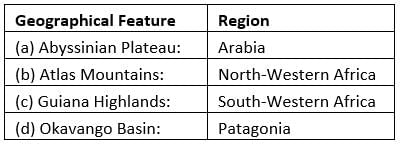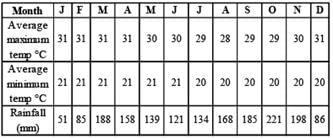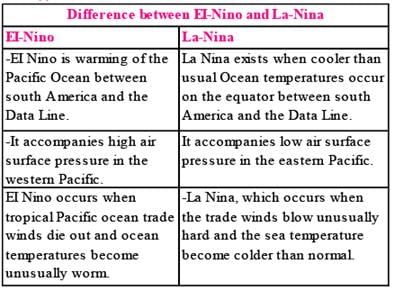Test: Physical Geography - 2 - UPSC MCQ
20 Questions MCQ Test - Test: Physical Geography - 2
Consider the following pairs:
1. Electromagnetic radiation
2. Geothermal energy
3. Gravitational force
4. Plate movements
5. Rotation of the earth
6. Revolution of the earth
Which of the above are responsible for bringing dynamic changes on the surface of the earth?
[2013]
1. Electromagnetic radiation
2. Geothermal energy
3. Gravitational force
4. Plate movements
5. Rotation of the earth
6. Revolution of the earth
On the planet earth, most of the freshwater exists as ice caps and glaciers. Out of the remaining freshwater, the largest proportion
[2013]
Variations in the length of daytime and night time from season to season are due to
[2013]
Which one of the following pairs is correctly matched?

[2013]
Which one of the following is the characteristic climate of the Tropical Savannah Region?
[2012]
Normally, the temperature decreases with the increase in height from the Earth’s surface, because
1. the atmosphere can be heated upwards only from the Earth's surface
2. there is more moisture in the upper atmosphere
3. the air is less dense in the upper atmosphere
Select the correct answer using the codes given below:
[2012]
Consider the following factors:
1. Rotation of the Earth
2. Air pressure and wind
3. Density of ocean water
4. Revolution of the Earth
Which of the above factors influence the ocean currents?
[2012]
Which of the following is/are cited by the scientists as evidence/evidences for the continued expansion of universe?
1. Detection of microwaves in space
2. Observation of redshift phenomenon in space
3. Movement of asteroids in space
4. Occurrence of supernova explosions in space
Select the correct answer using the codes given below:
[2012]
The jet aircrafts fly very easily and smoothly in the lower stratosphere. What could be the appropriate explanation?
1. There are no clouds or water vapour in the lower stratosphere.
2. There are no vertical winds in the lower stratosphere.
Which of the statements given above is/are correct in this context?
[2011]
What could be the main reason/reasons for the formation of African and Eurasian desert belt?
1. It is located in the sub-tropical high pressure cells.
2. It is under the influence of warm ocean currents.
Which of the statements given above is/are correct in this context?
[2011]
Westerlies in southern hemisphere are stronger and persistent than in northern hemisphere. Why?
1. Southern hemisphere has less landmass as compared to northern hemisphere.
2. Coriolis force is higher in southern hemisphere as compared to northern hemisphere.
Which of the statements given above is/are correct?
[2011]
What is difference between asteroids and comets?
1. Asteroids are small rocky planetoids, while comets are formed of frozen gases held together by rocky and metallic material.
2. Asteroids are found mostly between the or bits of Jupiter and Mars, while comets are found mostly between Venus and Mercury.
3. Comets show a perceptible glowing tail, while asteroids do not.
Which of the statements given above is/are correct?
[2011]
La Nina is suspected to have caused recent floods in Australia. How is La Nina different from El Nino ?
1. La Nina is characterized by unusually cold ocean temperature in equatorial Indian Ocean whereas El Nino is characterized by unusually warm ocean temperature in the equatorial Pacific Ocean.
2. El Nino has adverse effect on south-west monsoon of India, but La Nina has no effect on monsoon climate.
Which of the statements given above is/are correct?
[2011]
A layer in the Earth’s atmosphere called ionosphere facilitates radio communication. Why?
1. The presence of ozone causes the reflection of radio waves to earth.
2. Radio waves have a very long wavelength.
Which of the statements given above is/are correct?
[2011]
If a tropical rain forest is removed, it does not regenerate quickly as compared to a tropical deciduous forest. This is because
[2011]
What causes wind to deflect toward left in the Southern Hemisphere?
[2010]
A geographic region has the following distinct characteristics:
1. Warm and dry climate
2. Mild and wet winter
3. Evergreen Oak trees
The above features are distinct characteristics of which one of the following regions?
[2010]
Which one of the following reflects back more sunlight as compared to other three?
[2010]
A new type of El Nino called El Nino Modoki appeared in the news. In this context, consider the following statements:]
1. Normal El Nino forms in the Central Pacific Ocean whereas El Nino Modoki forms in Eastern Pacific Ocean
2. Normal El Nino results in diminished hurricanes in the Atlantic Ocean but El Nino Modoki results in a greater number of hurricanes with greater frequency.
Which of the statements given above is/are correct?
[2010]
A geographic area with an altitude of 400 metres has following characteristics.

If this geographic area were to have a natural forest, which one of the following would it most likely be?
[2010]















